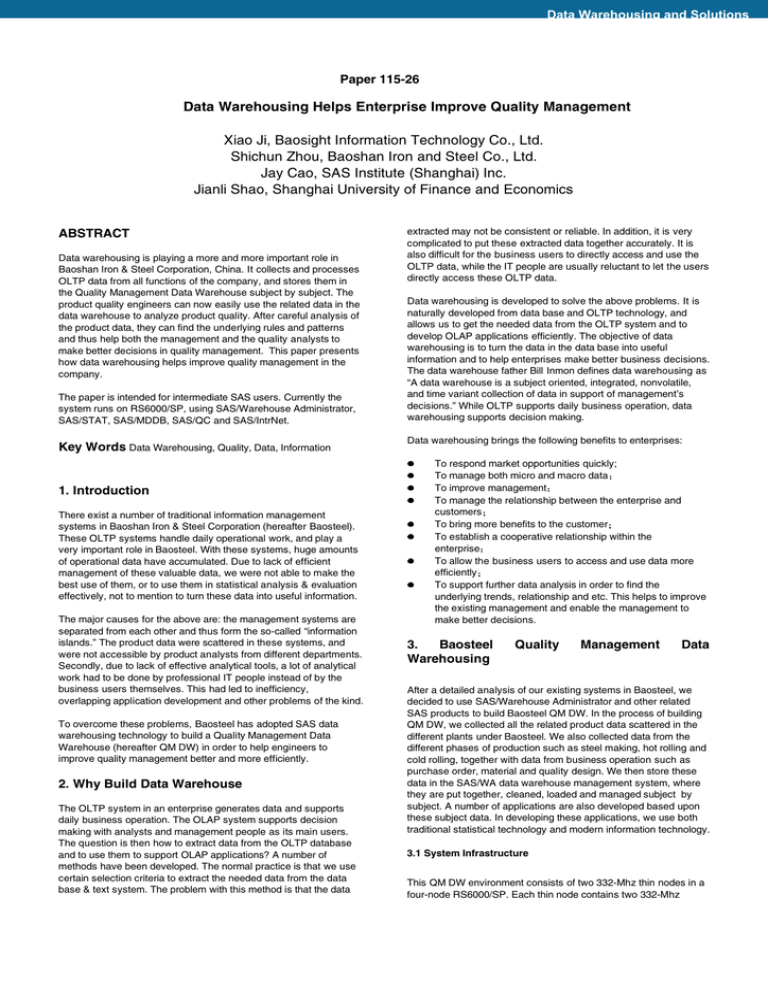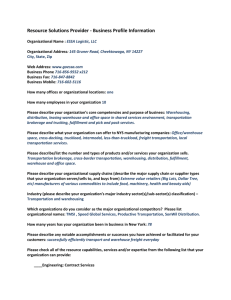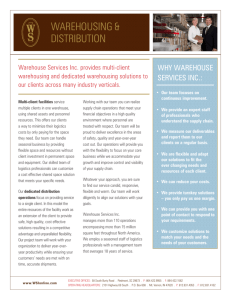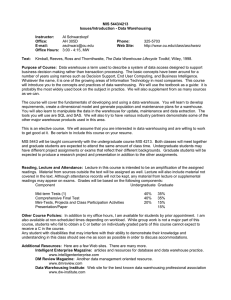Data Warehousing Helps Enterprise Improve Quality
advertisement

Data Warehousing and Solutions Paper 115-26 Data Warehousing Helps Enterprise Improve Quality Management Xiao Ji, Baosight Information Technology Co., Ltd. Shichun Zhou, Baoshan Iron and Steel Co., Ltd. Jay Cao, SAS Institute (Shanghai) Inc. Jianli Shao, Shanghai University of Finance and Economics ABSTRACT Data warehousing is playing a more and more important role in Baoshan Iron & Steel Corporation, China. It collects and processes OLTP data from all functions of the company, and stores them in the Quality Management Data Warehouse subject by subject. The product quality engineers can now easily use the related data in the data warehouse to analyze product quality. After careful analysis of the product data, they can find the underlying rules and patterns and thus help both the management and the quality analysts to make better decisions in quality management. This paper presents how data warehousing helps improve quality management in the company. The paper is intended for intermediate SAS users. Currently the system runs on RS6000/SP, using SAS/Warehouse Administrator, SAS/STAT, SAS/MDDB, SAS/QC and SAS/IntrNet. Key Words Data Warehousing, Quality, Data, Information 1. Introduction There exist a number of traditional information management systems in Baoshan Iron & Steel Corporation (hereafter Baosteel). These OLTP systems handle daily operational work, and play a very important role in Baosteel. With these systems, huge amounts of operational data have accumulated. Due to lack of efficient management of these valuable data, we were not able to make the best use of them, or to use them in statistical analysis & evaluation effectively, not to mention to turn these data into useful information. The major causes for the above are: the management systems are separated from each other and thus form the so-called “information islands.” The product data were scattered in these systems, and were not accessible by product analysts from different departments. Secondly, due to lack of effective analytical tools, a lot of analytical work had to be done by professional IT people instead of by the business users themselves. This had led to inefficiency, overlapping application development and other problems of the kind. To overcome these problems, Baosteel has adopted SAS data warehousing technology to build a Quality Management Data Warehouse (hereafter QM DW) in order to help engineers to improve quality management better and more efficiently. 2. Why Build Data Warehouse The OLTP system in an enterprise generates data and supports daily business operation. The OLAP system supports decision making with analysts and management people as its main users. The question is then how to extract data from the OLTP database and to use them to support OLAP applications? A number of methods have been developed. The normal practice is that we use certain selection criteria to extract the needed data from the data base & text system. The problem with this method is that the data extracted may not be consistent or reliable. In addition, it is very complicated to put these extracted data together accurately. It is also difficult for the business users to directly access and use the OLTP data, while the IT people are usually reluctant to let the users directly access these OLTP data. Data warehousing is developed to solve the above problems. It is naturally developed from data base and OLTP technology, and allows us to get the needed data from the OLTP system and to develop OLAP applications efficiently. The objective of data warehousing is to turn the data in the data base into useful information and to help enterprises make better business decisions. The data warehouse father Bill Inmon defines data warehousing as “A data warehouse is a subject oriented, integrated, nonvolatile, and time variant collection of data in support of management’s decisions.” While OLTP supports daily business operation, data warehousing supports decision making. Data warehousing brings the following benefits to enterprises: To respond market opportunities quickly; To manage both micro and macro data To improve management To manage the relationship between the enterprise and customers To bring more benefits to the customer To establish a cooperative relationship within the enterprise To allow the business users to access and use data more efficiently To support further data analysis in order to find the underlying trends, relationship and etc. This helps to improve the existing management and enable the management to make better decisions. 3. Baosteel Warehousing Quality Management Data After a detailed analysis of our existing systems in Baosteel, we decided to use SAS/Warehouse Administrator and other related SAS products to build Baosteel QM DW. In the process of building QM DW, we collected all the related product data scattered in the different plants under Baosteel. We also collected data from the different phases of production such as steel making, hot rolling and cold rolling, together with data from business operation such as purchase order, material and quality design. We then store these data in the SAS/WA data warehouse management system, where they are put together, cleaned, loaded and managed subject by subject. A number of applications are also developed based upon these subject data. In developing these applications, we use both traditional statistical technology and modern information technology. 3.1 System Infrastructure This QM DW environment consists of two 332-Mhz thin nodes in a four-node RS6000/SP. Each thin node contains two 332-Mhz Data Warehousing and Solutions Supplier Dimension Product Dimension Subjects Customer Dimension SAS/Warehouse Administrator Process Dimension The QM DW can be implemented using the client-server configurations. The warehouse meta data will be stored on the local host (the machine where SAS/Warehouse Administrator will also be installed). The client-server strategy for the QM DW will be the one shown in Figure 1. In this case, SAS/WA and the warehouse meta data are all located on the SP2 server, which is the local host. OLTP data is on the mainframe (remote host). Jobs to capture OLTP data on the remote host and update the data warehouse will be submitted on the local SP2 host. The QM DW is a collection of related fact tables surrounded by conformed dimensions. Some of the dimensions, such as the Supplier Dimension and the Customer Dimension, will be relevant only in the context of a single fact table. The Supplier Dimension will be joined to the color coating quality fact table. The Customer Dimension will be joined to the final output quality fact table. The Product Dimension is similar to the Material Dimension. The main difference between these two dimensions in the model is in the range of attributes selected for each one. Material Dimension The configuration of file systems for SAS storage is to build Raid0 and Raid5 stripe sets (64-Kb stripe width) that stripe across host I/O adapters and across disks. Most SAS I/O is predominately sequential and such a strategy will aggregate bandwidth. groups to create the necessary views of product and process quality data for cross-subject queries and analyses. An example of such cross-subject analysis is the KIV/KOV data mining applications. Time Dimension PowerPC 604e CPUs with 1 GB of memory. The maximum configuration of a thin node is four CPUs and 3 GB of memory. The node contains a single 50-Mhz I/O bus with a maximum bandwidth of 132 MBs and two PCI I/O slots. A high-speed fabric switch with 300-MB bi-directional bandwidth connects the two nodes. There is an integrated SCSI-2 F/W controller for the boot device and a 10Mbps Ethernet card. Steel Making Warehouse Metadata OLTP CT NE CON / S SA Scheduler Cold Rolling Bloom Submit Job Job CT SAS/CONNE Hot Rolling OLTP Updatedata Wire Color Coating DataMart Data Electric Galvanization (Zn) Electric Galvanization (Sn) IBMSP2Server: Local Host IBMOS/390: RemoteHost Figure 1. Physical Configuration of the QM DW Hot-Dip Galvanization Electromagnetic Steel Final Product 3.2 Database Design Table 1 Components of the QM DW As mentioned previously, the QM DW is a subject-oriented data warehouse with eleven subjects. These subjects are as follows: Steel Making Hot Rolling Cold Rolling Bloom Wire Color Coating Electric Galvanization (Zn) Electric Galvanization (Sn) Hot-Dip Galvanization Electromagnetic Steel Final Product The overall structure of the data warehouse is shown in Table 1. Each row of the table is a subject, while the columns represent the dimensions. The subjects of the data warehouse are data groups that can be used to support the analytical and reporting needs of management areas within the Technical Division. Several subjects of the data warehouse can also be combined into larger data 3.3 Data Subject Sample (Hot Rolling) The purpose of the Hot Rolling Subject is to provide an integrated view of all the product and process quality data relevant to hot rolling. The hot rolling process begins with blooms, billets, and slabs as primary input materials. The rolling process consists of pressing and squeezing these input materials into the desired shape. Unlike steel making, which affects the chemical composition of steel, hot rolling affects predominantly the mechanical properties of steel. It does so through a process known as annealing. At a minimum, the fact table of the Hot Rolling Subject should be designed to include all the critical measures used in the analysis of product and process quality at the hot rolling phase. Examples of critical measures that need to be put into the hot rolling fact table include the cooling temperature, the annealing temperature and annealing speed, the tensile strength, elongation, and impact work of materials. Additional measures, including the results of random Data Warehousing and Solutions tests, will also go into the fact table. The logical data model is outlined in Figure 2. Material Dimension TimeDimension Material_Key HotRollingProcessQualityFacts Time_Key Material Name Material Description Material Type Material Internal Grade Material DomesticGrage Material International Grade OtherMaterial Attributes Material_Key Time_key Process_ID Production_date Order_Number CoolingTemperature CoolingSpeed RollingTemperature RollingSpeed MechanicalProperties TestMeasures OtherFactMeasures ProcessDimension Process_ID ProcessName ProcessDescription ProcessType Plant_ID PlantName PlantDescription PlantType PlantOperator_ID PlantShift Test_ID Test_Name Test_Type Test_Description OtherProcessAttributes the user can easily store or access data in the data warehouse through client/server, web or others. They can now produce all kinds of reports they need at their will, and easily. Before, if the quality engineers needed data or reports, they must first of all submit their request to the IT people, who would then develop programs, and send back the reports to the users when they are done. This was very time consuming. 4.1 1580Hot Rolling Statistical Analysis System The management system in 1580 Hot Rolling Plant does not have the statistical analysis function. Therefore we developed a number of statistical analysis functions using SAS software for the purpose of quality management based upon the QM DW. This not only benefits the quality management but also helps process control in the plant. For example, we can now submit statistical reports to the manufacturing plant each month so that the plant can adjust some variable in the control process in order to enhance product accuracy. Figure 3 is a good illustration. Figure 2. Logical Data Model of the Hot Rolling Subject with Sample Dimension Attributes and Fact Measures Based on the logical data model, a physical data store (including views) can be implemented and made available to end users. The physical database containing the required data can be used by business analysts to perform ad hoc queries or create analytical reports. From our experience, we think that SAS/WA and other SAS products provide the advanced data analytical ability. They help simplify the whole process of data warehouse design, establishment & maintenance, and effectively handle the complicated analytical work in the enterprise. At the moment, with the help of QM DW, engineers from technology department in Baosteel are able to produce useful information using analytical tools themselves, and to produce the official product quality reports within minutes. This helps reduce end-users’ dependence upon the IT people. In a word, data warehousing enables our engineers to effectively conduct product quality analysis, and significantly reduce the time of report producing from days before to minutes at the moment. The quality of these reports is also significantly enhanced in predicting reliable quality trends. Figure 3 Mechanical Function Illustration 4.2 1420 Cold Rolling Quality Management Statistical Analysis System This system is developed by the end users themselves. At the moment it is mainly used to analyze the hardness distribution of normal material and the DI material, linear analysis of harness and chemical component and etc. It is effectively used in Baosteel. Figure 4 illustrates the actual relationship between SF temperature and hardness. 4. Applications of Quality Management Data Warehouse Baosteel is the first metallurgical company in China to adopt the data warehousing technology. This technology provides effective management of information resources, and more importantly and it helps the management make better decisions. The building of this QM DW involves the active participation of the business users together with the strong support from the top management. It aims at solving major business problems. For this reason the data in QM DW are not isolated from each other, rather they are related. This brings a lot of convenience to the users. For example, before QM DW, it was difficult for an engineer to study the relationship between the cold rolling and the steel making functions since they belong to two separate processes. With the data warehouse, this can now be easily done. In addition, with the development of modern information technology, Figure 4 Relationship Between SF Temperature & Hardness Data Warehousing and Solutions 4.3 KIV/KOV Data Mining Application This application provides an integrated data store that can support SPC(statistical process control). More specifically, the QM DW provides integrated data on product and process quality to support the statistical modeling of KIV(key input variables) and KOV(key output variables) using Enterprise Miner™ or SAS/STAT®. The KIV and KOV are derived from data on product and process quality. Since most inputs generally go through multiple manufacturing processes before reaching the stage of finished products, a set of KOV in one process could be the KIV of the next process. SPC allows engineers to optimize the process of quality control by using the desired values of KOV to pre-select the values of the KIV. KIV and KOV relationship diagram is shown in figure 5. This figure illustrates how to produce reports rapidly using MDDB. The user can now build one or two dimensional reports through web. In addition, various other statistical reports can be produced by selecting different analytical variables and methods to meet business user’s needs. Conclusion Data warehousing can be effectively used in quality management. It helps enhance quality management, and enables the users to access the data they need efficiently and to do further analysis at the same time. It not only helps the user save time, but also helps provide accurate and reliable statistical analysis results. It helps the management to predict the product quality accurately and hence provides better decision support. We believe that data warehousing enjoys a bright future in China. References W.H.Inmon. Building the Data Warehouse, John Wiley & Sons Inc., 1993 Data Warehousing Overview Theory and Business Concepts, SAS Institute Inc. Contact Information Figure 5 KIV/KOV Relationship Illustration 4.4 Intranet Information Display and On-line Analysis We have also developed some web applications on our internal intranet. This helps the end-user store & access the latest information in the data warehouse. The end user can now access to detailed information in the data warehouse through web, and produce reports rapidly using MDDB. They can also achieve calculation functions through web. Figure 6 illustrates one web application. Your comments and questions are valued and encouraged. Contact the author at: Author Name: Xiao Ji Company: Baosight Information Technology Co., Ltd., P.R.C. Address: 688 Fujin road, Baoshan District City state ZIP: 201900 Work Phone: 86-21-56191018 Fax: 86-21-56191018 Email: samji@21cn.com Web: http://www.baosight.com Author Name: Shichun Zhou Company: Baoshan Iron&Steel Co., Ltd., P.R.C Address: Technical Department, Guoyuan, Baoshan District City state ZIP: 201900 Work Phone: 86-21-56785519 Fax: 86-21-26645908 Email: sczhou@baosteel.com Web: http://www.baosteel.com Author Name: Jay Cao Company: SAS Institute (Shanghai) Inc., P.R.C Address: 803 Yun Hai Mansion, 1329 Huai Hai Zhong Road City state ZIP: 200031 Work Phone: 86-21-64725536 Fax: 86-21-54560570 Email: jay.cao@sas.com Web: http://www.sas.com Figure 6: MDDB Application Illustration




